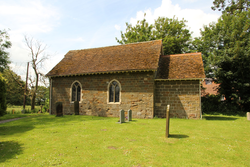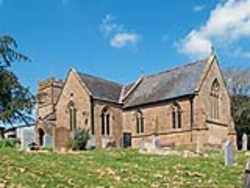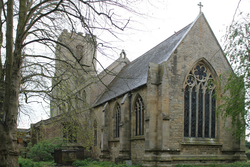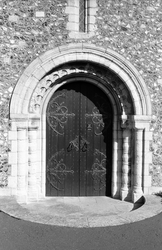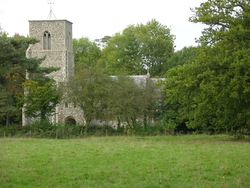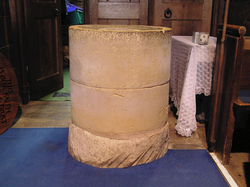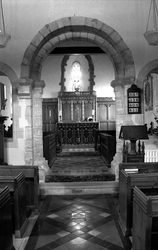
The Corpus of ROMANESQUE SCULPTURE in Britain & Ireland

St Margaret (medieval)
Parish church
Langton is a small village in East Lindsey, 1½ miles W of Horncastle. The church is at the E end of the village and is a small building of greenstone, limstone and red brick. The original church on the site was medieval and had a W tower, whise foundations are visible at the W end. It was restored in 1750 and again, by W. Scorer, in 1890, so that now it is mostly his work. It is a small church with nave and chancel only. A coped coffin lid bearing sculptural decoration was reset into the rebuilt W wall of the nave in 1891; previously it had been located in the chancel pavement, and this is the only Romanesque feature.
Parish church
Middle Chinnock is 3 miles NE of Crewkerne in generally undulating country, an area of South Somerset notable as good farming country. Chiselborough Hill rises abruptly to the N of the Chinnock stream; the chalk hills of Dorset are not far to the S. The small, compact, settlement of Middle Chinnock is only a field away from the larger village of West Chinnock. The church of St Margaret is at the S end of the settlement, packed together quite closely with the rectory, manor house and farm. The medieval nave has a porch and W tower, and the plan at this end of the church seems unchanged. It had transepts added in 1836 and has a chancel that was restored in the 1860s. Remains from the Romanesque period include the S doorway to the nave, and a font. There are also re-set carved stones in the exterior walls of the N transept and chancel.
Parish church
Sibsey is a village in the East Lindsey district of Lincolnshire, 5 miles N of Boston and 26 miles SE of Lincoln. The village is in the Licolnshire fens and is the centre of a thriving farming area. The main street of the village is the A16 which runs N from Boston to Louth and Grimsby. The church is in the village centre on the E side of the main street.
It consists of a W tower, an aisled nave with a S porch, and chancel with a N vestry. Of these the 4-storey tower is 13thc in its 3 lowest stages with an embattled 15thc top storey. The nave aisles were added in the 12thc, and a clerestorey in the 15thc. In 1840 the nave piers and responds were heightened, dramatically altering the interior elevation. The chancel was rebuilt in 1855, by Kirk but contains late-medieval features. Construction is of ashlar with some red brick patching. Romanesque sculpture is found in the N nave doorway and in the S and N nave arcades.
Parish church
The late 12thc. W tower was rebuilt in 1950 after bomb damage, and
vestries were added to either side. The nave and aisles were rebuilt in 1835,
following a fire, but the chancel is medieval. The
vestry and organ chamber on the S side of the
chancel date from 1893, at which time the medieval S
arcade was reopened.
Parish church
This small church consists of a chancel, a nave, and a large double-storied N porch, that was meant to carry a tower (Pevsner, 282). The 19th-century timber chancel arch sits on short shafts with reset 12th-century capitals. The nave, though restored in 1874-6, is Norman in origin, with an early 12th-century S door. A slab that is now part of the altar is also Norman.
Parish church
The seven South Elmham villages; St James, All Saints, St Nicholas, St Cross, St Margaret, St Michael and St Peter, to which may be added Homersfield, sometimes referred to as South Elmham St Mary, lie in a scattered group between Bungay and Halesworth in NE Suffolk, to the W of the Roman road known as Stone Street. North Elmham (the centre of the see until 1071) is over 30 miles away, to the NW of Norwich, and both apparently took their name from Aethelmaer (bishop of East Anglia 1047-1070) the landholder before the Conquest. This is not certain; Tricker suggests that the name meant villages where elm trees grew. The land here is flat, generally arable and sparsely populated; the villages rarely more than a few houses clustered around the church without shops or pubs. St Margaret's village consists of a scattering of houses and the church along a minor road running on the S side of the Beck, a tributary of the Waveney. Alongside the church to the S is the parkland surrounding South Elmham Hall. The hall itself is 0.6 m SW of the church, in the neighbouring parish of South Elmham St Cross (qv). The church is of flint, with a nave, chancel and W tower. The nave is 12thc., with a S doorway and a S window of that date. The S doorway is protected by a two-storey porch of knapped flint and brick, probably 15thc. The N doorway is blocked and has a pointed segmental head. Perpendicular windows were added to the nave in the 15thc., one on the S side and two on the N. There is a N rood stair. The chancel is 15thc. to judge from its windows and an ogee-headed wall tomb on the N side. Also on the N is a 19thc. pseudo-chapel of knapped flint, housing the organ and a vestry (Pevsner considers it early 14thc., and it is certainly in that style). The chancel arch is 19thc. The tower is 14thc., with a very tall tower arch, a W window with flowing tracery, 14thc. bell-openings, a polygonal SE stair and diagonal buttresses with flushwork. The top of it is flat and leaded. The church was thoroughly restored in 1838. The S doorway is the only feature with Romanesque sculpture.
Parish church
The church consists of a chancel, nave, W tower and S porch. The Savile transeptal chapel was added by T.C. Hine, who restored the church in 1873. The two-light square-headed chancel window isc.1400 whilst the pointed chancel arch is probably 100 years or so earlier. In the floor of the nave is a 14thc. grave slab of unusual design. The tower bears a repair date of 1663, and an epitaph to William Chappell, Bishop of Cork and Ross, who spent some time at Bilsthorpe during the Civil War and died in Derby in 1649. The only Romanesque feature is the font.
Parish church
Binsey is a small village by the River Thames about 1.5 miles NW of Oxford. Although this little church is now within Oxford City, it is hidden away along a narrow wooded lane, half a mile N of Binsey village. Its earliest datable stonework is the round-headed S doorway of the late 12thc. It is uncertain whether the porch was built at the same time (as suggested by Sherwood and Pevsner), or added in the 13thc remodelling (as posited by Clark). The church has always been a two-cell structure and much of it was rebuilt, at least from waist height, in the 13thc. The present church comprises a chancel, a nave and a central bell-cote. The S doorway is the surviving main Romanesque feature, and the plain font probably also dates to the 12thc.
Parish church
The hamlet of Alstone lies some 4 miles W of Tewkesbury. In 1844 Alstone was transferred from Worcestershire to Gloucestershire, but remains within the diocese of Worcester. The church, which is situated in the middle of the settlement, consists of a nave, a chancel, a N aisle and a S porch with a modern timber belfry over the E end of the nave. The nave has been rebuilt, as has much of the chancel; the responds of the chancel arch and the S doorway remain in position from the 12thc building. The remains of a 12thc piscina have been incorporated into the S wall of the chancel.
Parish church
The church comprises a nave with a W porch, a W
bell-turret, a 13thc. S arcade
and a simple two-bay
chancel.
The plain W doorway has a tympanum in a raised
surround.
